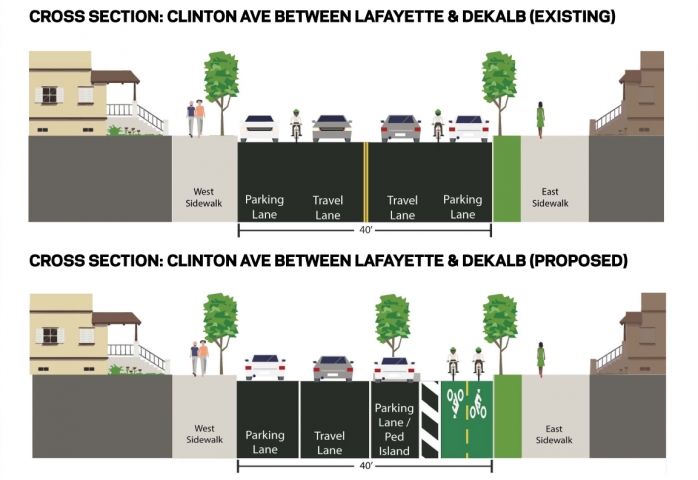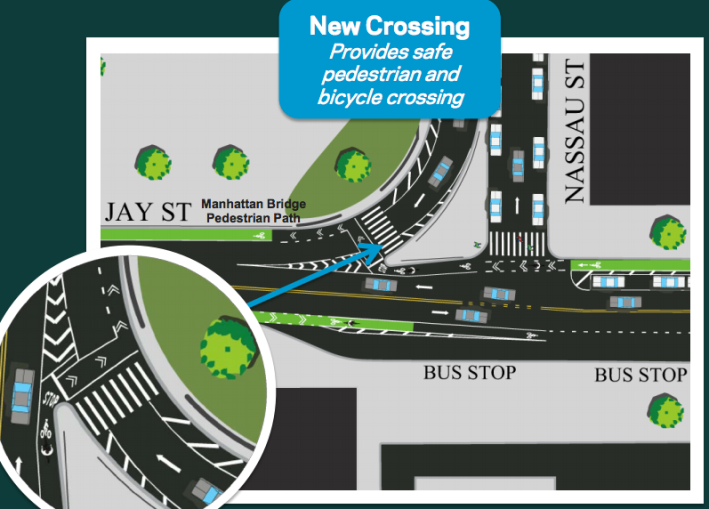
After withdrawing its plan for a two-way protected bike lane on Clinton Avenue last month, DOT will start over with a series of public workshops to develop a new plan for walking and biking safety in Clinton Hill and Fort Greene.
DOT Bicycle and Greenway Program Director Ted Wright shared the news at last night’s Community Board 2 transportation committee meeting.
At the same meeting, the committee declined to endorse a new signalized crosswalk at the Jay Street exit ramp from the Manhattan Bridge, one of the final elements in the agency's plan for a protected bike lane on Jay Street.
Wright said the purpose of the upcoming meetings will be to develop a new plan for bike and pedestrian safety in the neighborhood. "Everything is on the table. This is not just going to be us talking about Clinton Avenue again,” he said. "It’s a full scale re-look at the entire process."
Local elected officials had promoted the meeting as an "update" on the Clinton Avenue project, and like last month it was packed with opponents of the protected bikeway plan. When Wright took questions from attendees about the new round of workshops, hostility to the old plan carried over. “Why are we having workshops? If we don’t want it, why are we having workshops about it?” said Clinton Avenue resident Bayo Oygunsanya.
Wright then presented the final design elements of the Jay Street project. The CB 2 transportation committee voted for most of the Jay Street plan in March, but at the time DOT had not finalized the design for the Manhattan Bridge exit ramp near Nassau Street or the blocks of south of Fulton Mall.

The updated plan puts a signalized crossing at the Manhattan Bridge off-ramp, giving pedestrians and cyclists dedicated signal time to cross. The plan would also remove the fence that currently blocks pedestrians from making the crossing.
Meanwhile, Wright said DOT will hold off on implementing a protected lane south of Fulton. There are too many bus stops on the two blocks between Fulton and Schermerhorn for DOT's bikeway design elsewhere on Jay Street to work. At those other stops, the bike lane protection is interrupted so bus drivers can go across the bike lane and pick up passengers at the curb. Applying that treatment to blocks where there are several bus stops in a row would not be much different than current conditions.
DOT could try out concrete bus stop islands on the left side of the bike lane, a design that the city has yet to implement anywhere. But Wright said the agency will work with the MTA to reduce the number of bus stops on those two blocks.
The signalized crossing at the bridge exit was in direct response to requests from CB 2, but committee member Bill Harris proposed tabling a vote on it until the 84th Precinct confirmed it could "enforce all this stuff." It was not clear what stuff he was referring to.
Wright said DOT has been communicating with NYPD about the project. The agency wants to implement the redesign this summer.
"I want to hear from the police on this, because the enforcement is going to be crazy," Harris said. "I don't know why it has to be done this summer, it's waited this long. I'm glad it's coming, I'm glad you all are rethinking it, but I want it to be right."
In the end, the committee deadlocked 5-5 on whether to endorse the new signalized crossing at the ramp. While DOT's Keith Bray said the agency wants "consensus" on projects before moving forward, the agency is free to proceed without a vote from the community board.





